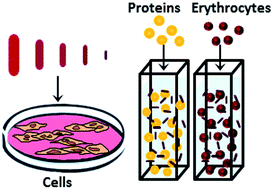Size dependent biological profiles of PEGylated gold nanorods†
Abstract
The perspective of introducing plasmonic particles for applications in biomedical optics is receiving much interest. However, their translation into clinical practices is delayed by various factors, which include a poor definition of their biological interactions. Here, we describe the preparation and the biological profiles of gold nanorods belonging to five different size classes with average effective radii between ∼5 and 20 nm and coated with polyethylene glycol (PEG). All these particles exhibit decent stability in the presence of representative proteins, low cytotoxicity and satisfactory compatibility with intravenous administration, in terms of their interference with blood tissue. However, the suspension begins to become unstable after a few days of exposure to blood proteins. Moreover, the cytotoxicity is a little worse for smaller particles, probably because their purification is more critical, while undesirable interactions with the mononuclear phagocyte system are minimal in the intermediate size range. Overall, these findings hold implications of practical relevance and suggest that PEGylated gold nanorods may be a versatile platform for a variety of biomedical applications.


 Please wait while we load your content...
Please wait while we load your content...